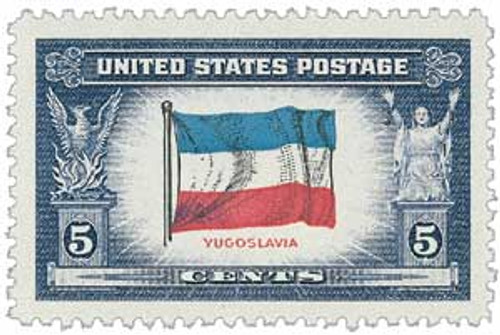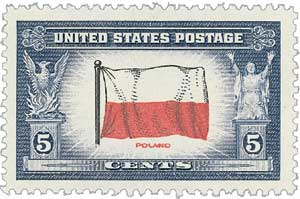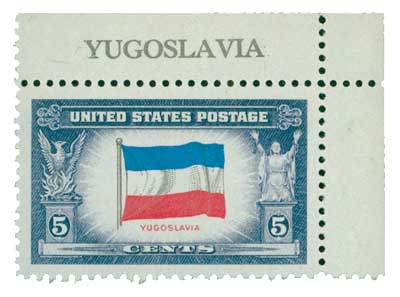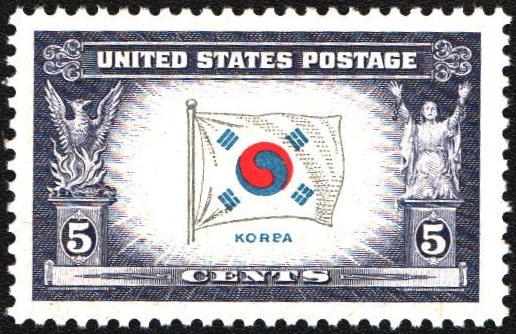
# 917a - 1943 5c Flag of Yugoslavia
5¢ Flag of Yugoslavia
Overrun Countries Series
City: Washington, D.C.
Quantity: 14,999,646
Printed by: American Bank Note Company
Printing Method: Flat-Plate
Perforations: 12
Color: Blue violet, blue, dark rose, and black
Start Of Overrun Countries Series

On June 22, 1943, the first stamp in the Overrun Countries series, U.S. #909, was issued. These stamps were created to send a message of hope to war-torn residents of the overrun countries.
After receiving several designs from artists who felt the current U.S. postage stamps were unattractive, President Franklin Roosevelt began to consider the types of stamps he wanted to issue. He sought to show the world that America was in this war to achieve world peace, not military dominance. With this in mind, the President suggested the U.S. issue a series of stamps picturing the flags of all the overrun nations in Europe.
In the border surrounding each flag, Roosevelt suggested picturing the Phoenix – an ancient symbol of rebirth. He believed “It might tell those suffering victims in Europe that we are struggling for their own regeneration.” The other side of each flag pictured a kneeling woman “breaking the shackles of oppression.”

When the time came to print the stamps, the Bureau of Engraving and Printing was unable to print the multiple colors needed for each flag, so the American Bank Note Company received a special contract for this series. There are several errors, freaks, and oddities among the Overrun Countries stamps, including misregistrations, misshapen letters, and double impressions of the country names.
Additionally, a 5¢ denomination – the foreign rate for first class postage – was chosen so the stamps could be used on overseas mail. The stamps were printed in relatively small quantities and were in high demand as soon as they were issued, with stocks across the country running out almost as soon as they were released.

The first 12 stamps were issued throughout 1943. The final stamp, featuring the flag of Korea, was issued on November 2, 1944. There was a particularly interesting error of this stamp in which a plate flaw resulted in some of the stamps appearing to read “KORPA.”
Click here to buy individual Overrun Countries stamps and to learn about each of the countries they honor. And click here to order the complete set.
5¢ Flag of Yugoslavia
Overrun Countries Series
City: Washington, D.C.
Quantity: 14,999,646
Printed by: American Bank Note Company
Printing Method: Flat-Plate
Perforations: 12
Color: Blue violet, blue, dark rose, and black
Start Of Overrun Countries Series

On June 22, 1943, the first stamp in the Overrun Countries series, U.S. #909, was issued. These stamps were created to send a message of hope to war-torn residents of the overrun countries.
After receiving several designs from artists who felt the current U.S. postage stamps were unattractive, President Franklin Roosevelt began to consider the types of stamps he wanted to issue. He sought to show the world that America was in this war to achieve world peace, not military dominance. With this in mind, the President suggested the U.S. issue a series of stamps picturing the flags of all the overrun nations in Europe.
In the border surrounding each flag, Roosevelt suggested picturing the Phoenix – an ancient symbol of rebirth. He believed “It might tell those suffering victims in Europe that we are struggling for their own regeneration.” The other side of each flag pictured a kneeling woman “breaking the shackles of oppression.”

When the time came to print the stamps, the Bureau of Engraving and Printing was unable to print the multiple colors needed for each flag, so the American Bank Note Company received a special contract for this series. There are several errors, freaks, and oddities among the Overrun Countries stamps, including misregistrations, misshapen letters, and double impressions of the country names.
Additionally, a 5¢ denomination – the foreign rate for first class postage – was chosen so the stamps could be used on overseas mail. The stamps were printed in relatively small quantities and were in high demand as soon as they were issued, with stocks across the country running out almost as soon as they were released.

The first 12 stamps were issued throughout 1943. The final stamp, featuring the flag of Korea, was issued on November 2, 1944. There was a particularly interesting error of this stamp in which a plate flaw resulted in some of the stamps appearing to read “KORPA.”
Click here to buy individual Overrun Countries stamps and to learn about each of the countries they honor. And click here to order the complete set.







